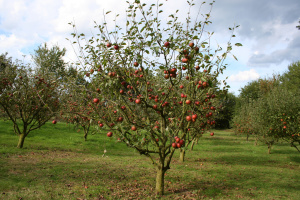
Like anything else, you have to give your apple tree a little tender loving care in order for it to produce really good apples. Pruning and trimming your apple tree can stimulate growth and keep your apple trees healthy, strong and productive.
Steps in Pruning Young Apple Trees
Many people are afraid to cut their young apple trees. However, the first five to six years are the most crucial for the trees’ growth. By annually pruning during these years, you are actually forming the architecture of the tree and training it to grow into a conical shape. Also important to note is that younger trees heal very well from pruning whereas older trees take longer.
It is best to prune in the late winter or early spring. Begin by removing several of the lowest branches in order to raise the base of the tree. With sharp secateurs or pruning clippers, cut these branches close to the branch bark ridge of the tree. Make sure the clippers are as close to the tree as possible to get the cleanest cut.
The next step is to prune or trim the other branches. Look for branches that are growing towards the middle or interior of the tree. Remember, your goal is to make the tree grow in a conical shape, so you should look for branches that are not growing outward. Once you’ve spotted a branch, it’s very important to cut it at an angle with your clippers so that rain water will drain off of the stem. Cut immediately above a bud facing outward so that the branch will grow in the outward direction. By pruning this way, you’ll encourage lateral buds to grow and form new branches.
Next, prune away any branches that are competing with the main top branch, called the strong central leader. Cut these branches down so that the central leader is 12 to 15 inches higher. This step is part of training the tree to grow in the right shape.
Once you’ve pruned your new tree for five or six years, its shape should be established, and you can focus on lightly pruning the tree during the summer to remove suckers, fast growing laterals and broken branches.
Pruning Old Apple Trees
Old apple trees that have been neglected may need to be heavily pruned. Trees with congested, tight branches won’t produce well and are more susceptible to diseases, so pruning allows air to get to all the branches and keeps the tree healthier. Begin by pruning dead, diseased or damaged branches. These branches may appear discolored or flaking. Work from the inside out while using a telescopic pruner or a pruning saw to make your work easier.
Remove whole branches that do not have buds as well as any crossing branches. Any branches growing downward will also need to be pruned as they take away nutrients from the tree but will not produce fruit. Prune so that scaffold branches are spaced 12 to 18 inches apart. This will allow sunlight to reach all the sides of the tree and get to all the fruiting branches.
You will also need to remove whorls. These growths, which are more common in older apple trees, occur when three or more small limbs are growing from the same place. With multiple limbs growing from one spot on the tree, the branch is weakened and in danger of breaking. You should find out which limb is the biggest and healthiest of the group of limbs and remove the other branches from the whorl.
